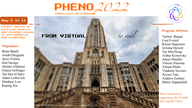Speaker
Description
If dark matter annihilates into high-energy Standard Model particles, the remnants of these final states can be discovered, for example by GeV-scale secondary photons from the galactic center. It is much more difficult to discover a scenario where dark matter annihilates into very low- energy photons. This may occur in the case where the annihilation produces a cascade of hidden- sector states that subsequently mix into visible photons. We study the impact of ultraviolet photons from dark matter annihilation on cosmological history. These photons may (1) alter the recombination history by exciting/ionizing atomic hydrogen, and (2) affect star formation by dissociating the molecular hydrogen coolants in the first star-forming galaxies. We use Planck data to constrain the cosmological history of a benchmark dark matter annihilation model and present new opportunities for early-universe probes of hidden sectors.

